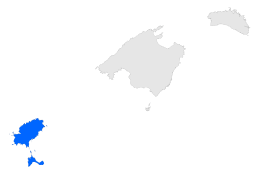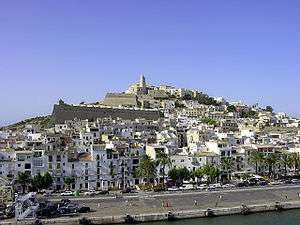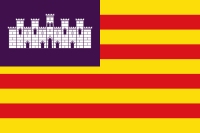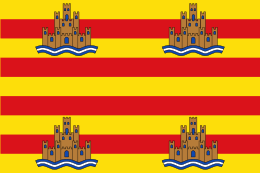Pityusic Islands
The Pityusic Islands,[1][2] often referenced simply as the Pityuses (Catalan: Pitiüses [pitiˈuzəs], Spanish: Pitiusas; from the Greek πιτύα pitýa, pine tree), or commonly but informally (and ambiguously) as the Pine Islands, is the name given collectively to the Balearic Islands of Ibiza (Catalan: Eivissa), Formentera, S'Espalmador and other small islets in the Mediterranean Sea.
| Islas Pitiusas • Illes Pitiüses | |
|---|---|
 | |
| Etymology | Greek: Πιτυοῦσσαι, romanized: Pityûssai, lit. 'pine-covered' (islands) |
| Geography | |
| Location | Mediterranean Sea |
| Coordinates | |
| Archipelago | Balearic Islands |
| Area | 655.8 km2 (253.2 sq mi) |
| Highest elevation | 476 m (1,562 ft) |
| Highest point | Talaia, Ibiza |
| Administration | |
Spain | |
| Autonomous Community | Balearic Islands |
| Province | Balearic Islands |
| Largest settlement | Ibiza (pop. 49,783) |
| Demographics | |
| Population | 160,025 (1 January 2019) |
| Pop. density | 244.0/km2 (632/sq mi) |
Geography
The islands are situated approximately 100 kilometres (62 miles) southwest of the island of Majorca, and approximately 80 km (50 mi) east of the Cap de la Nau in the Iberian Peninsula.
History
The first known name of the islands was the Ancient Greek geonym Πιτυοῦσσαι Pityûssai ("covered in pine trees").[3]
From about 200 BCE, the islands were used as a base by Cilician pirates. They and a renegade Roman general, Quintus Sertorius, who had formed an alliance with the pirates, were driven out by a large Roman fleet, commanded by Caius Annius Luscus.
The two largest of the islands, under the names Ebyssus (Ibiza) and Ophiusis (Formentera), were listed in Claudius Ptolemy's Geography (2nd century CE). Ptolemy noted that Ebyssus had a town by the same name.
Administration
The Pine Islands are sometimes grouped together as part of the Balearic Islands, or else considered separate with the Balearics proper being Mallorca and Menorca (which together with their islets form the Gymnesian Islands). Politically, they are part of the autonomous community of the Balearic Islands.
Initially, they were administratively part of the same insular council (of Ibiza and Formentera), but since 2007 they are now separated between the insular council of Ibiza and the insular council of Formentera (each one is also assimilated to a single comarca), which are two of the four main administrative subdivisions of the province (and autonomous community) of the Balearic Islands.
Gallery
 Beach on Ibiza
Beach on Ibiza Ibiza Town
Ibiza Town Beach on Formentera
Beach on Formentera
Flags and coats of arms
 Flag of Spain
Flag of Spain Flag of the Balearic Islands
Flag of the Balearic Islands Flag of Ibiza
Flag of Ibiza Flag of Formentera
Flag of Formentera Emblem of the Island Council of Ibiza
Emblem of the Island Council of Ibiza.svg.png) Coat of arms of Sant Antoni de Portmany
Coat of arms of Sant Antoni de Portmany.svg.png) Coat of arms of Sant Joan de Labritja
Coat of arms of Sant Joan de Labritja.svg.png) Coat of arms of Santa Eulària des Riu
Coat of arms of Santa Eulària des Riu Coat of arms of Ibiza
Coat of arms of Ibiza
See also
- Gymnesian Islands (Illes Gimnèsies)
Further reading
- Kuhbier, Heinrich; Alcover, Josep Antoni; Guerau d'Arellano Tur, Cristòfol, eds. (1984). Biogeography and Ecology of the Pityusic Islands. Monographiae Biologicae, Volume 52. The Hague, The Netherlands: Dr. W. Junk (Kluwer). ISBN 978-90-6193-105-8.
External links
- (in Spanish) Lagartija de las Pitiusas - Podarcis pityusensis (Boscá, 1883), Enciclopedia virtual de los vertebrados españoles, Alfredo Salvador, Museo Nacional de Ciencias Natural (CSIC), Madrid, published 20-06-2006.
- A new species of rail (Aves, Rallidae) from the Upper Pleistocene and Holocene of Ibiza (Pitiusic Island, Western Mediterranean), McMinn M., Palmer M. & Alcocer J.A., Ibis journal (ISSN 0019-1019), volume 147, pp. 706-716, published 2005. Referenced by the Mediterranean Institute for Advanced Studies (IMEDEA).
- Numerous places were given names like Pityûssai, Pityussa, Pityusa, or similar names by the Ancient Greeks,especially in Anatolia and Greece Archived 2009-08-30 at the Wayback Machine: the pre-Hellenic name of Miletus of the Leleges was also Pityussa (Strabo, 14.1.3); Spetses' ancient name was Pityoussa; during the Roman Civil Wars Sertorius with some Cilician pirates effected a landing at an island of Pityussa on the North African coast of Mauretania, and was driven off (Plutarch, Life of Sertorius 7).